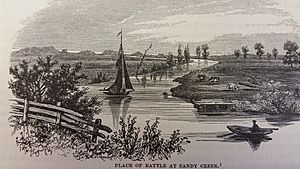Battle of Big Sandy Creek facts for kids
Quick facts for kids Battle of Big Sandy Creek |
|||||||
|---|---|---|---|---|---|---|---|
| Part of the War of 1812 | |||||||
 Battle of Big Sandy Creek |
|||||||
|
|||||||
| Belligerents | |||||||
| Commanders and leaders | |||||||
| Stephen Popham |
Melancthon T. Woosley Daniel Appling |
||||||
| Strength | |||||||
| 153 marines and sailors | 150 riflemen 125 Indians |
||||||
| Casualties and losses | |||||||
| 13 killed 140 captured (30 of whom were wounded) |
2 wounded | ||||||
The Battle of Big Sandy Creek was a small but important fight during the War of 1812. It happened in northwestern New York on May 29–30, 1814. American soldiers and Oneida Indians worked together. They planned a surprise attack on British troops and sailors. The British were chasing them inland from Lake Ontario.
The Americans lost their element of surprise. One of their boats was found by the British. Even so, their plan worked. The entire British force had to surrender. This stopped their advance.
Contents
Why the Battle Happened: Background
After attacking Fort Oswego in early May 1814, the British moved. They went to the Galloo Islands in northern Lake Ontario. From there, they could watch for American supplies. They wanted to stop supplies going to Sackets Harbor, New York.
At Sackets Harbor, the Americans had new warships. These included two brigs, USS Jefferson and Jones. They also had a frigate, Superior. These ships needed weapons and ropes to be ready. The supplies came from the Brooklyn Navy Yard on Long Island. They traveled to Albany, New York, then up the Mohawk River to Wood Creek and Oneida Lake. Finally, they reached the Oswego River.
These important supplies still needed to get from Oswego to Sackets Harbor. It was very important to move them without the British knowing.
On April 21, 1814, Commodore Isaac Chauncey sent orders. He told Lieutenant Melancthon Taylor Woolsey to pick officers and men. Their job was to take the shipbuilding supplies north.
The Battle Begins
On the rainy evening of May 28, Lieutenant Woolsey set out. He had 150 riflemen with him. Major Daniel Appling led these soldiers. They were in 19 boats loaded with supplies.
On the morning of May 29, they reached the mouth of the Big Salmon River. One of their boats had disappeared. The British found this lost boat. This meant the British knew about Woolsey's mission. The surprise was gone.
At Big Salmon, the American forces met the Oneida Indians. There were about 120 to 130 Oneida warriors. Woolsey had sent for them the day before. The Oneidas marched north along the shore. The boats continued in the lake. By noon on May 29, they reached the mouth of the Big Sandy Creek. All the boats went as far inland as they could.
Woolsey then sent someone to look for British ships. The lookout found a British gunboat and three barges. They were heading right for the American forces. Woolsey quickly called for help from nearby local soldiers. He got ready for a fight.
At 8 a.m., the British started firing cannons. They shot at the American forces from the mouth of Big Sandy Creek. The American soldiers hid along the creek's shoreline. They waited for the British to move inland. Around 10 a.m., the British forces came further up the creek. The Americans jumped out from where they were hiding. A short battle, lasting only ten minutes, began. The British officers quickly gave up. They wanted to avoid more injuries.
Who Won? Losses in the Battle
The Americans had very few injuries. Only two were wounded: one Oneida Indian and one U.S. rifleman.
Major Appling wrote a report on May 30. He listed the British losses. Thirteen British soldiers were killed. Two lieutenants from the Royal Marines and 28 sailors and marines were wounded and captured. Seven officers and 133 other soldiers were taken prisoner. The Americans also captured three British gunboats, two cutters, and one gig.
After the Battle: What Happened Next?
The Americans won this battle. But the British Navy still had ships on Lake Ontario. So, the Americans had to move their supplies by land. This was the only way to get them to Sackets Harbor.
Ox carts carried most of the supplies. But there was one very heavy item: a 4-ton anchor cable. This cable was for the USS Superior. Two hundred volunteers carried this huge cable on their shoulders. They carried it for the remaining 20 miles. One hundred men at a time carried about 100 pounds each. They did this for three days. They successfully avoided the British the whole time.

